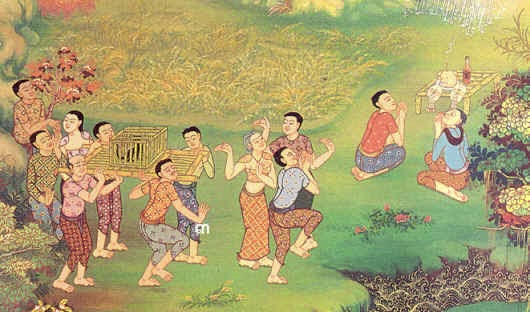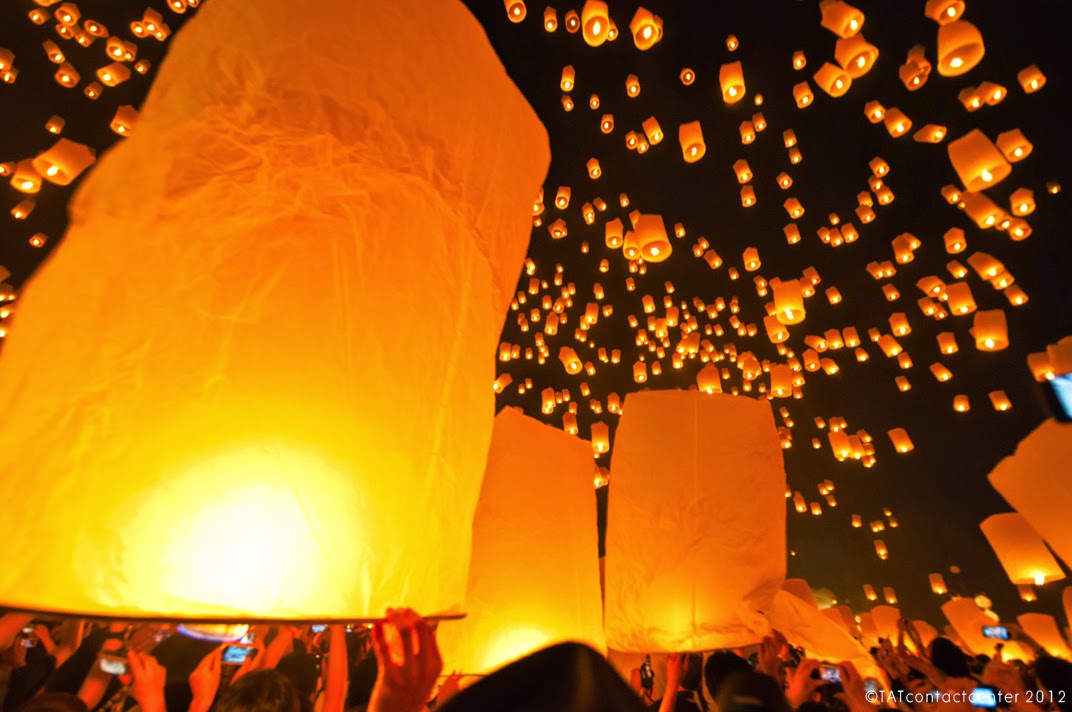วันอาทิตย์ที่ 10 พฤษภาคม พ.ศ. 2558
วันอาทิตย์ที่ 26 เมษายน พ.ศ. 2558
Hae Nang Meaw Ritual [French]
Le festival de Hae Nang Maew en Thaϊlande
Les agriculteurs du district de Wang Sai Poon à la province de Phichit effectué une cérémonie rituelle pour demander précipitations après la pluie a cessé de tomber pendant trois semaines consécutives.
Les agriculteurs victimes de la sécheresse dans les villages du district de Wang Sai Poon se sont réunis pour participer à une cérémonie traditionnelle appelée Hae Nang Maew (แห่ นาง แมว). Les trois semaines de sécheresse avait endommagé de nombreuses cultures de riz, et les agriculteurs ne pouvait pas cultiver davantage de plantes en raison du manque d'eau. En outre, le quartier est en dehors de la zone d'irrigation royale, et de nombreux agriculteurs ont besoin d'eau pour élever leurs cultures de riz en saison.
Cérémonie Hae Nang Maew est commun dans les provinces du nord et du nord-est de la Thaïlande, et il se déroule habituellement en cas de sécheresse. Cette pratique commence par un défilé mené par un chat femelle dans une cage. Le défilé se rendra à différents domaines de laisser les villageois asperger d'eau sur le chat. Après la cérémonie, le chat va être mis en liberté. Selon la croyance traditionnelle, c'est un signe de bon augure pour les précipitations.
วันเสาร์ที่ 18 เมษายน พ.ศ. 2558
Hae Nang Meaw Ritual [Eng]
Hae Nang Meaw Ritual
Hae nang maew ritual is a ritual of Krog Pra people. In the year of lacking rain the villagers will parade a cat to call the rain for their field. The villagers begin the ritual with finding female cats and put her into the basket or a kind of bamboo basket. Insert a stick of wood to the basket and parade the cat from house to house. In front of the parade there is a man who carries a footed tray and calling to invite the other villagers to join the parade and there are also many numbers of tom-toms. The very important things in the parade are a figure of the clouds, men and women genitals, which are made from the clay in different shapes.
The figures of men and women genitals are place in a crosswise position, like there are copulating. Then the villagers will shout the words of Hae nang maew ritual with cheerful. When the parade reached each house, the owner of the house is going to throw the water to the cat in the basket till it wet and give the members of the parade prizes, which is an alcoholic beverage, food, etc. The parade goes to every houses in the village if it is no rain coming they will do all of this again in the next day or soon.
The reason that they use a female cat because the villagers believe that the male god will send the rain, which is his broth, to the angel of the earth, Who is the female god. She will receive his broth (or the rain) into her womb. After raining the plants will grow very well. The villagers will have enough food to eat. Hae nang maew ritual is in July-August.
This ceremony has died out but it still shows us the unity and the old way to solve the farming problems of the villagers
Hae nang maew ritual is a ritual of Krog Pra people. In the year of lacking rain the villagers will parade a cat to call the rain for their field. The villagers begin the ritual with finding female cats and put her into the basket or a kind of bamboo basket. Insert a stick of wood to the basket and parade the cat from house to house. In front of the parade there is a man who carries a footed tray and calling to invite the other villagers to join the parade and there are also many numbers of tom-toms. The very important things in the parade are a figure of the clouds, men and women genitals, which are made from the clay in different shapes.
The figures of men and women genitals are place in a crosswise position, like there are copulating. Then the villagers will shout the words of Hae nang maew ritual with cheerful. When the parade reached each house, the owner of the house is going to throw the water to the cat in the basket till it wet and give the members of the parade prizes, which is an alcoholic beverage, food, etc. The parade goes to every houses in the village if it is no rain coming they will do all of this again in the next day or soon.
The reason that they use a female cat because the villagers believe that the male god will send the rain, which is his broth, to the angel of the earth, Who is the female god. She will receive his broth (or the rain) into her womb. After raining the plants will grow very well. The villagers will have enough food to eat. Hae nang maew ritual is in July-August.
This ceremony has died out but it still shows us the unity and the old way to solve the farming problems of the villagers
วันศุกร์ที่ 17 เมษายน พ.ศ. 2558
Phi Ta Khon Festival [French]
Phi Ta Khon
Le tout est appelé Bun Luang, partie d'un bouddhiste vacances mérite-fabrication également connu comme Bun Phawet.
Le premier jour est le Festival Ghost lui-même, aussi appelé Wan Ruam (jour de montage). Les habitants de la ville invitent la protection de Phra U-Pakut, l'esprit de la rivière Mun. Ils tiennent ensuite une série de jeux et de prendre part à une procession portant des masques en balles de riz ou de noix de coco laisse avec des chapeaux fabriqués à partir de vapeur de riz, ainsi que des vêtements de patchwork. Ils portent aussi des cloches et agitent phallus en bois.
Les origines de cette partie de la fête sont traditionnellement attribués à une histoire de la Vessantara Jataka dans lequel le Bouddha dans une de ses vies passées comme un prince fait un long voyage et a été présumé mort. Les célébrations à son retour étaient tellement rauque à réveiller les morts.
Le deuxième jour du festival incorpore des éléments de la Rocket Festival, plus de costumes et de danse concours et plus de défilés. Le troisième est dernier jour, les villageois écoutent les sermons de moines bouddhistes.
Phi Ta Khon Festival [Thai]
ประเพณีผีตาโขน
"ผีตาโขน" เป็นชื่อการละเล่นชนิดหนึ่ง โดยผู้เล่นทำรูปหน้ากาก มีลักษณะหน้าตาหน้าเกลียดน่ากลัวมาสวมใส่และแต่งตัวมิดชิด เมื่อเข้าขบวนแห่จะแสดงท่าทางต่างๆระหว่างมีงานบุญตามประเพณีประจำปีท้องถิ่นพื้นบ้าน เท่าที่ทราบ การละเล่นผีตาโขนนี้มีเฉพาะในท้องถิ่นที่อำเภอด่านซ้ายและอำเภอนาแห้ว จังหวัดเลย ซึ่งแต่เดิมอยู่ในเขตท้องที่อำเภอด่านซ้ายเท่านั้น ที่อื่นไม่มีปรากฏว่ามีการละเล่นนี้ นับว่าเป็นสิ่งที่แปลกอย่างหนึ่ง
ต้นกำเนิดผีตาโขน
กล่าวกันว่า การแห่ผีตาโขนเกิดขึ้นเมื่อครั้งที่พระเวสสันดรและนางมัทรีจะเดินทางออกจากป่าเพื่อกลับสู่เมือง บรรดาผีป่าหลายตนและสัตว์นานาชนิดอาลัยรักจึงพาแห่แหนแฝงตัวแฝงตน มากับชาวบ้านเพื่อมาส่งทั้งสองพระองค์กลับเมือง เรียกกันว่า "ผีตามคน" หรือ "ผีตาขน" จนกลายมาเป็น "ผีตาโขน" อย่างในปัจจุบัน
การแต่งกายผีตาโขน
ผู้เข้าร่วมในพิธีนี้จะแต่งกายคล้ายผีและปีศาจใส่หน้ากากขนาดใหญ่ ทำจากกาบมะพร้าวแกะสลักและสวมศีรษะด้วยกระติ๊บข้าวเหนียว
วันเสาร์ที่ 28 มีนาคม พ.ศ. 2558
วันศุกร์ที่ 27 มีนาคม พ.ศ. 2558
Hae Nang Maew Ritual [Thai]
ประเพณีแห่นางแมว
การแห่นางแมวเป็นพิธีอ้อนวอนขอฝน ซึ่งจะจัดทำขึ้นเมื่อท้องถิ่นนั้นแห้งแล้งฝน ไม่ตกตามฤดูกาล สาเหตุที่ฝนไม่ตก ท่านผู้รู้กล่าวไว้ว่า น้ำฝนนั้นเป็นน้ำของเทวดา ดังมีศัพท์บาลีว่า เทโว ซึ่งแปลว่า น้ำฝน เป็นเอกลักษณ์ของความดี ความบริสุทธิ์ สิ่งแวดล้อมเป็นพิษมากๆ ควัน และละอองเขม่าน้ำมัน ห่อหุ้มโลกทำให้เป็นภัยแก่มนุษย์ ผู้ที่จะล้างอากาศได้ทำให้ละอองพิษพวกนั้นตกลงดิน ทำให้อากาศสะอาดคือ "เทโว" หรือ "ฝน" นั่นเอง ดังจะเห็นได้จากเมื่อฝนหยุดตกใหม่ๆ อากาศจะสดชื่น ระงมไปด้วยเสียงของกบ เขียด
ชาวไทยโดยเฉพาะกลุ่มเกษตรกรที่จำเป็นต้องใช้น้ำในการเกษตรกรรมจะต้องนำนางแมว (แมวตัวเมีย) โดยคัดเลือกแมวไทยพันธุ์สีสวาด (คนไทยโบราณเรียก แมวมาเลศตามภาพ) ตัวที่มีรูปร่างปราดเปรียว สวยงามตั้งแต่ 1-3 ตัว นำนางแมวมาใส่กระบุงหรือตะกร้าหรือเข่งก็ได้ สาเหตุที่ต้องเลือกแมวพันธุ์นี้เพราะเชื่อว่า สีขนแมวเป็นสีเดียวกับเมฆ จะทำให้เกิดฝนตกได้ แต่บางแห่งก็ใช้แมวดำ
ก่อนที่จะนำนางแมวเข้ากระบุง คนที่เป็นผู้อาวุโสที่สุด จะพูดกับนางแมวว่า "นางแมวเอย …ขอฟ้าขอฝน ให้ตกลงมาด้วยนะ" พอหย่อนนางแมวลงกระบุงแล้ว ก็ยกกระบุงนั้นสอดคานหามหัวท้าย จะปิดหรือเปิดฝากระบุงก็ได้ แต่ถ้าปิดต้องให้นางแมวโดนน้ำกระเซ็นใส่ ตอนที่สาดน้ำด้วยจะต้องถูกต้องตามหลักประเพณี
ผู้หญิงที่เข้าร่วมในพิธีแห่ จะผัดหน้าขาว ทัดดอกไม้สดดอกโตๆ ขบวนแห่จะร้องรำทำเพลงที่สนุกสนานเฮฮา เมื่อขบวนแห่ถึงบ้านไหน แต่ละบ้านจะต้องออกมาต้อนรับอย่างเต็มที่ เพราะเกรงว่าแมวจะโกรธ และจะบันดาลไม่ให้ฝนตกลงมา และมีความเชื่อว่า ถ้าแห่นางแมวแล้วฝนจะตก ภายใน 3 วันหรือ 7 วัน นอกจากนี้ พิธีแห่นางแมวขอฝน จะเป็นการช่วยเรียกให้ฝนตกแล้ว ยังถือว่าพิธีนี้เป็นการสร้างความสัมพันธ์กับผู้คนในหมู่บ้านให้แน่นแฟ้นขึ้น เนื่องจากจะต้องมีการช่วยเหลือกันในการประกอบพิธีอีกด้วย
Phi Ta Khon Festival [English]
Phi Ta Khon
Phi Ta Khon(also known as Ghost Festival) is the most common name for a group of festivals held in Dan Sai, Loei province, Isan, Thailand.
The whole event is called Bun Luang, part of a Buddhist merit-making holiday also known as Bun Phawet.
The first day is the Ghost Festival itself, also called Wan Ruam (assembly day). The town’s residents invite protection from Phra U-pakut, the spirit of the Mun river. They then hold a series of games and take part in a procession wearing masks made of ricehusks or coconut leaves with hats made from rice steamers, plus patchwork clothing. They also wear bells and wave woodenphalluses.
The origins of this part of the festival are traditionally ascribed to a story of the Vessantara Jataka in which the Buddha in one of his past lives as a prince made a long journey and was presumed dead. The celebrations on his return were so raucous as to wake the dead.
The second day of the festival incorporates elements of the Rocket Festival, plus costume and dance contests and more parades.
On the third and final day, the villagers listen to sermons from Buddhist monks.
วันอาทิตย์ที่ 15 มีนาคม พ.ศ. 2558
Yi Peng Lantern Festival [French]
Yi Peng
A Chiang Mai, il y a une fête qui est bien connue s’appelle Yi Peng : la pleine lune de la seconde mois, comme la douzième mois de la calendrier lunaire en Thaï qui correspond de la seconde mois dans le calendrier traditionnel de l'ancien royaume du nord Lanna. Cette fête s’agit de la lanterne affircheant dans les maisons et les temples , et même lançant dans le ciel du nuit.
L’histoire
Les annals Yonok et Jamtevi sont enregistrés qu’une fois s’est passée un choléra dans la région Haripunjaya(ou Haripunchai) . C’est la raison qui les habitant immigraient vers la ville de Hongsaowadee pendant 6 ans après être revenu à la vieille ville. Lorsqu’on a dû sortir de la ville, on a établi des pots du bâton pour adorer le dieu. Des bâton et les bougie ont flotté pour les personnes pertes. On s’appelle Loi kamode et Loi fai.
Lanterne du Ciel
Lanterne du Ciel
Les personnes au nord de la Thaïlande vénérent Pra Ged Kaew Ju La Manee (Le cristal de Chedi dans le ciel où il y a les chaveaux de Bouddha) et ce culte par envoyer le Khom Loy dans le ciel. A Chiang Mai était la scène de plusieurs Khom Loy lançant environ mille ou plus.
Yi Peng Lantern Festival [English]
In Chiang Mai the celebration is known as Yi Peng (the full moon of the second month), as the twelfth month in the Thai Lunar Calendar corresponds to the second month in the traditional calendar of the old northern Lanna kingdom. The festival features beautifully illuminated lanterns, which are either carried, displayed in houses and temples, and even launched into the night sky.
History Annals in the Yonok and Chamadevi Kingdon, it is recorded that one time there was cholera in the region Haripunjaya. It make many burgers evacuate in Hongsawadee (Myanmar) for 6 years to go back to the old town. When this time that is the day of evacuation came. We have to make sacrifices to put pots and candles floating on the water to relatives who have passed away so-called phantom float or fly lantern.
Sky Lanterns It is believed that launching the lantern can send a person’s bad luck and misfortune away into the sky, especially if it disappears from view before the fire goes out. Often people will say a short prayer before launching the balloon. Sometimes they will also place their address at the balloon. Anyone who later finds the balloon can then claim money from the sender. In this way the good fortune is shared.
People in Northern Thailand also venerate Pra Ged Kaew Ju La Manee (Crystal Chedi in which the Buddha’s hair is kept), and worship this by sending air ballooned lantern into the sky. The Chiang Mai area has been the scene of massed balloon launches.
Yi Peng Lantern Festival [Thai]
ยี่เป็ง
ในเชียงใหม่ ประเพณีนี้เป็นที่รู้จักกันในชื่อประเพณียี่เป็ง (หมายถึงคืนที่พระจันทร์เต็มดวงเป็นครั้งที่สองของเดือน) เป็นเดือนที่12 ของปฏิทินจันทรคติไทย หรือเป็นเดือนที่สองของปฏิทินของทางอาณาจักรล้านนา เทศกาลนี้มีจุดเด่นที่ความสวยงามจากแสงสีของโคมลอย ซึ่งถูกปล่อยจากทั้งทางบ้านและทางวัดลอยสู่ท้องฟ้าในยามค่ำคืน
ความเป็นมาในพงศาวดารโยนกและจามเทวี มีบันทึกว่าครั้งหนึ่งได้เกิดอหิวาตกโรคขึ้นในแคว้นหริภุญไชย (หรือหริภุญชัย) ทำให้ชาวเมืองต้องอพยพไปอยู่เมืองหงสาวดี นานถึง 6 ปี จึงจะเดินทางกลับมายังบ้านเมืองเดิมได้ เมื่อเวลาเวียนมาถึงวันที่จากบ้านจากเมืองไป จึงได้มีการทำกระถางใส่เครื่องสักการบูชา ธูปเทียนลอย ลอยตามน้ำเพื่อให้ไปถึงญาติพี่น้องที่ล่วงลับไป เรียกว่า การลอยโขมด หรือลอยไฟ
โคมลอยเชื่อกันว่าการปล่อยโคมจะสามารถนำพาความโชคร้ายออกไปจากผู้ปล่อยโคมได้ โดยเฉพาะอย่างยิ่งถ้าโคมนั้นหายไปจากระยะสายตาก่อนที่โคมจะดับ คนส่วนใหญ่มักจะขอพรและเขียนที่อยู่ของตนเองลงไปที่โคมก่อนที่จะปล่อยโคมออกไป โดยใครก็ตามที่พบโคมที่ลอยมาจะสามารถเรียกเงินจากเจ้าของโคมได้ เพื่อเป็นการแบ่งปันโชคลาภกับผู้อื่น
ผู้คนทางตอนเหนือของประเทศไทยเคารพนับถือพระเกศแก้วจุฬามณี(เจดีย์แก้วที่บรรจุพระเกศาของพระพุทธเจ้า) จึงมีการสักการะโดยการปล่อยโคมลอยขึ้นไปสู่ท้องฟ้า ซึ่งทำให้บริเวณนั้นเต็มไปด้วยกลุ่มโคมลอยจำนวนมาก
สมัครสมาชิก:
บทความ (Atom)





